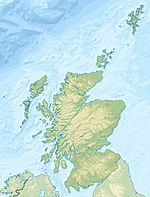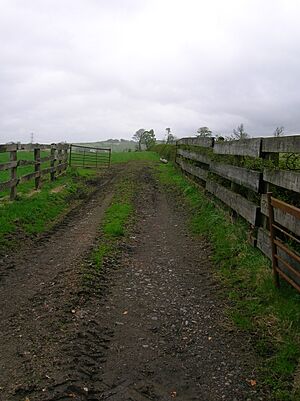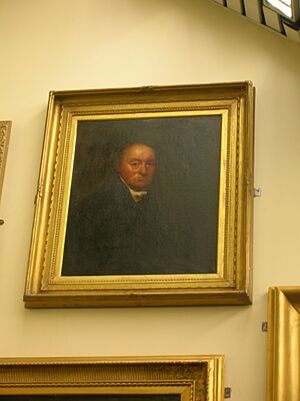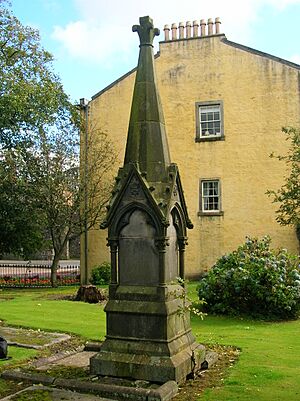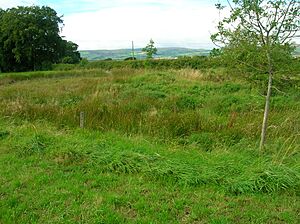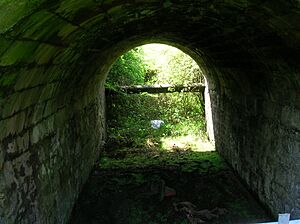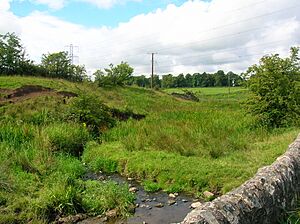Broadstone Castle facts for kids
Broadstone is a historic place in North Ayrshire, Scotland. It's located near the small village of Gateside, about half a mile east of Beith. Broadstone was once part of the old Barony of Giffen.
Quick facts for kids Broadstone Castle |
|
|---|---|
| Barrmill, North Ayrshire, Scotland UK |
|
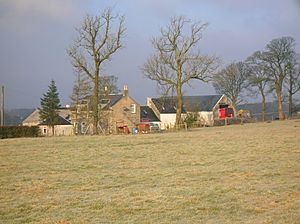
Broadstone Hall near the site of the old castle
|
|
| Coordinates | 55°44′33″N 4°36′39″W / 55.7426°N 4.610883°W |
| Type | Tower |
| Site information | |
| Owner | Private |
| Controlled by | Clan Montgomery |
| Open to the public |
No |
| Condition | Removed |
| Site history | |
| Built | 15th century |
| Built by | John de Liddel |
| In use | Until 18th century |
| Materials | Stone |
Contents
The Story of Broadstone Castle
What Happened to the Castle?
Broadstone Castle was a ruin until around 1850. When the Broadstonehall Farm buildings were being rebuilt, the old castle was taken down. Its stones were used to help build the new farm. The rocky area where the castle stood, called the Broadstone Crags, is still there today. There was even a path lined with trees and parts of an old garden that survived until the farm was built.
The Old Barony Mill
Most old baronies, which were areas of land controlled by a lord, had a water mill. This mill was run by the lord. People living on the land were usually required to bring their grain to this mill to be ground into flour. A small part of their grain was taken as payment. This system, called "thirlage," ended in the late 1700s. After that, many mills were left empty because people could choose where to grind their grain.
The name 'Crooked Dam' comes from a small house that used to be near the Powgree Burn. Remains of a mill pond show that this house was likely where the miller lived. The old barony mill itself was probably located below the site of the crooked dam.
Families Connected to Broadstone
The Montgomery Family
The Montgomerys were an important family linked to Broadstone. The Barony of Broadstone was owned by John de Lyddale in 1452. Later, Robert Montgomerie of Broadstone became the second son of the 3rd Lord Montgomerie.
Sir Hugh Montgomerie (1560–1636) was born here in 1560. He was the son of Adam, the 5th Laird of Broadstone. He married the daughter of John Montgomery of Hessilhead. Before 1568, he bought land from Hugh, the third Earl of Eglinton. Hugh had a daughter named Janet, who married Troilus, the second son of Adam Montgomery of Giffen. Another family member, Andrew Nevin, inherited the Monkredding estate in 1581. He married Janet, daughter of Adam Montgomery, the fourth laird of Broadstone Castle.
The Ulster Connection
In 1603, Hugh Montgomery traveled with King James I and VI to London. The king was going to take the English throne. Hugh's brother, George, was a church leader who became one of the king's chaplains. These strong connections helped Hugh get a large piece of land in Ulster, Ireland. He even hosted Con O'Neill, an Irish lord, at Broadstone and helped him get a pardon from Queen Elizabeth I.
Hugh Montgomery brought many Scottish Protestants from his Irish lands to Ulster in 1600. Later, more Protestants from this area were moved to Ireland after an Irish uprising. Hugh was knighted by King James in 1605. He was given the title Viscount Montgomery of the Great Ardes in 1622. He passed away in 1636 at 76 years old.
Hugh Montgomery is known as one of the "founding fathers" of the Ulster-Scots. This group of people settled in Ulster, Ireland, from Scotland. He is credited with bringing linen weaving and manufacturing to the area around Lurgan in Ireland. He also built mills and helped develop harbors. Some of the family from the nearby lands of Roughwood also went with Hugh Montgomerie to Ireland. They became successful merchants in Dublin.
The Shaw Family

In 1650, Hugh Montgomery gave a mortgage on the Broadstone lands to his brother-in-law, Sir John Shaw. Sir John stayed at the castle sometimes until after 1700. The Shaw family slowly sold off parts of the estate. Eventually, only the farm where the castle stood remained. The family, from Greenock, bought the estate in 1650. The castle was last lived in during the early 1700s.
The Brown Family
In 1798, Hugh Brown, a merchant from Beith, bought Hill of Beith Castle. He had already bought parts of the Broadstone lands before this. He also owned parts of other nearby lands. He built his large house at Brae-head House, which was later known as Crummock Park. His son, also named Hugh, inherited the property in 1809. Another Hugh Brown of Broadstone inherited it in 1857.
A memorial at Beith Auld Kirk remembers the second Hugh Brown of Broadstone (1787-1857) and his wife Margaret Caldwell (1783-1845). Hugh Brown was listed as a Justice of the Peace and an important person in Beith in 1837.
Bogston House and Estate
Bogston was once a home of the Montgomerie family. It was located between South Barr, Hayhills, and Bogfaulds Farms. Today, this area is part of a military base called DM Beith. Bogston used to be a large estate with many trees, orchards, and gardens. It was part of the Giffen Barony. The Earl of Eglinton sold this property to Robert Montgomerie in 1663. Later, Bogston became a farm. However, when the military storage facility was built, Bogston was torn down. Now, only a small group of trees shows where it once stood.
Windyhouse Farm
Windyhouse Farm is still standing today. It's at the corner of the road to Gateside. In the past, another road ran past it, connecting to several farms and cottages. These included Ward, Scoup, Bogfauld, Birsieknowe, and Whitespot. These places are now inside the MOD Beith military base.
Windyhouse had a "retting pit" for preparing flax. Flax is a plant used to make linen. The flax would soak in water for about four to six days. The leftover water, which was full of chemicals, was used as a liquid fertilizer.
Close to Windyhouse was a deep hole, possibly an old quarry. It was later used to get rid of dead animals, tree stumps, and extra soil. This hole is known as the 'Baney Hole'. It is still visible today as a wet area in the field. There were also small buildings nearby. The foundations of one are in the garden of Windyhouse.
The old name for the lands of Windyhouse was 'Neubotle'. Windyhouse No.10 was an ironstone and clay mine that was closed before October 1875.
Quarries, Lime Kilns, and Railways
Because of the type of rock underground in this part of Ayrshire, there are many limestone quarries. Lime kilns were common in the countryside. They were used to heat limestone to make lime, which helped improve soil for farming. Nettlehirst near Barrmill had one of the last large traditional lime kilns, which operated until the 1970s.
Broadstone has the remains of one of the largest early stone-built kilns. This kiln must have caused a lot of air pollution in the area. However, it also created many jobs. It sits right next to the limestone quarry that supplied it with rock. The road running past is still called 'Reek Road' (meaning "smoke road").
Old maps from 1858 show that the 'Hillhead Railway' ran from Barkip Junction to the quarry. This railway was part of a branch line to Kilbirnie. At first, there were sidings and a way to transfer materials. Later, a direct connection was built. The line did not last into the 1900s. It might have been a narrow-gauge railway, which is suggested by the surviving tunnel or overbridge.
Old maps also show that a marble quarry was located nearby. It is now filled in. The limestone from this quarry was so good that it was used as marble. It was very popular for making fireplace surrounds.
The old quarry is known locally as Hennis Planting. This name comes from a worker who died at the site.
Images for kids


